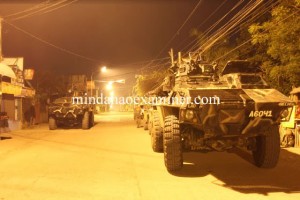
An eerie night in Zamboanga City in southern Philippines. (Mindanao Examiner Photo)
ZAMBOANGA CITY (Mindanao Examiner / Oct. 31, 2013) – Zamboanga City’s crisis management committee headed by Mayor Maria Isabelle Salazar has flatly rejected Thursday a local resolution passed by the City Council to temporarily lift the curfew here to allow residents to observe the traditional All Saints’ Day and All Souls’ Day.
Christians, who practise the tradition, usually spend the nights at cemeteries with their family and pray and reminisce the past of their departed.
The CMC has imposed the curfew since September following three weeks of deadly street battles between security forces and separatist rebels who stormed several villages in Zamboanga. The fighting, which started September 9, killed and wounded over 400 people and forced more than 100,000 villagers to flee their homes.
“In response to a City Council resolution calling for the lifting of the curfew, the CMC today decided to retain the imposition of curfew from 12 midnight up to 4 a.m. Those spending the night in cemeteries (should) remain where you are during curfew hours and resume movement/activities after curfew,” it said.
The CMC order virtually imprisoned those staying at cemeteries for 4 hours until they are allowed on the streets. It also ordered a ban on the sale and drinking of liquor, and prohibited the bringing of firearms, bladed weapons and similar items, playing of loud music, gambling and use of firecrackers and pyrotechnics inside cemeteries. Soldiers and policemen are also deployed in cemeteries.
Various sectors in Zamboanga have also been complaining on the continued imposition of curfew and members of the City Council are also calling for the lifting of this, but Vice Mayor Cesar Ituralde said it is up to the military authorities to decide whether to lift the curfew or not.
Salazar has originally imposed a 9-hour curfew, after the fighting, she reduced the curfew to 5 hours – from 12 p.m. to 5 a.m. – from the original 8 p.m. to 5 a.m. in the whole of Zamboanga and then further adjusted this up to 4 a.m.
Every night, dozens of civilians are being apprehended by the police for violating the curfew and many of them are briefly detained after interrogations.
Even media workers need to get a so-called “curfew pass” from the CMC for them to be able to do their job at night. But the curfew pass is not a guarantee that journalists and reporters, especially those working for radio stations, would not be apprehended. A group of reporters from dxRZ Radyo Agong was briefly held by the police. And not even their media cards were honored.
Groceries and supermarkets were also forced to reduce store hours, and hotels and restaurants and other night establishments are also affected by the curfew. Provincial buses from Cagayan de Oro and Pagadian cities have cut off its trip to Zamboanga at night because of the curfew hours.
The night scene in Zamboanga is a now a reminiscent of what the city looked like 20 years ago – dark and silent with just dogs roaming on the streets – and yet the local government has been appealing to residents to help rebuild Zamboanga from the ashes or war, and recently from the devastations brought about by natural calamities.
Local legislators are also questioning now the continued imposition of curfew and its economic effects on Zamboanga, a month after military and police quelled a rebellion launched by the Moro National Liberation Front under Nur Misuari. Salazar said the curfew will continue until security forces are finished clearing at least 5 areas occupied by rebels during the siege of Zamboanga. (Mindanao Examiner)

